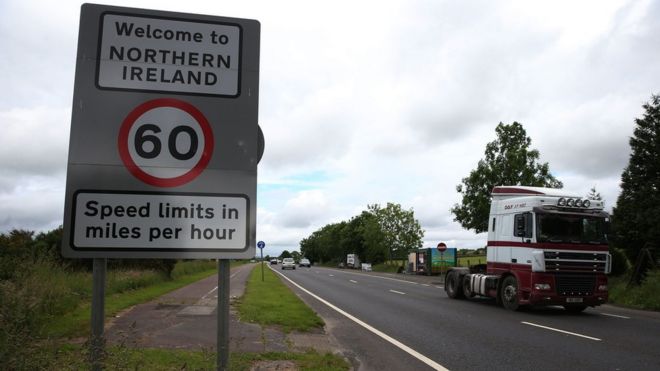Britain’s Brexit negotiators have issued an open invitation to people smugglers anywhere in Europe: “Welcome to Britain, the way in is through Ireland.”
 By insisting there “will be no return to the hard borders of the past,” as Theresa May’s Government does in its latest position paper covering Britain’s future relationship with the EU, Britain has printed up the “open door” invitation.
By insisting there “will be no return to the hard borders of the past,” as Theresa May’s Government does in its latest position paper covering Britain’s future relationship with the EU, Britain has printed up the “open door” invitation.
“There will be no need for physical infrastructure, such as new border posts,” insists Brexit Secretary David Davis’s department in its latest cobbled-together policy paper. And that means the future status of the land border between Northern Ireland and its EU neighbour, the Republic of Ireland would somehow be frictionless or open.
For those people who live on either side of the border that is a formula for a return to the days of smuggling.
“We used to have a high old time, smuggling goods backwards and forwards in the old days,” Francie Keenan, who lives not far from the border in County Down, told Felix Magazine. “Then came the Troubles and the checks were stepped up and although it made it more difficult it was still possible when you are familiar with the territory.”
In simple terms, anything short of a Trump-style wall along the full length of the 310-mile border would be impossible to police without huge increases in resources to provide 24-hour monitoring of the estimated 280 crossings on roads, lanes, and farm tracks.
It will become the backdoor into Britain through Irish ports and airports such as Cork, Dublin, the port of Dun Laoghare and many others with direct links to Europe.
Smuggling
Ireland is already a favoured route for people smugglers anxious to avoid the direct ports into England and Scotland. The National Crime Agency (NCA) has identified modern slavery and human trafficking as a growing problem in Northern Ireland.
A total of 34 victims of slavery have been detected in the past year by the Police Service of Northern Ireland (PSNI). Every one of them had been trafficked through ports in the Republic.
One Special Branch officer working in County Fermanagh, who cannot be named, told Felix Magazine that “the service has been gearing up for some time, well over the past year, for an increase in human trafficking because of Brexit.”
“It just makes it inevitable, and the smugglers will know this. If the only way into Britain is through south Ireland, they will perfect the routes. They will become cuter and more sophisticated. If I were in their position I would see it as an open invitation.”
Despite the complexities of the border issue, Davis has visited Dublin and Belfast since taking up his post as Britain’s chief Brexit negotiator but he has not bothered to visit the Irish border to see for himself the potential problems or talk to locals about their anxieties. On the other hand his opposite number in the EU negotiating team, the former French Foreign Minister Michel Barnier, has taken the time to visit businesses near the border to discuss their worries about Brexit and the border. He said at the time that there was “always a way” of avoiding a hard border if there was “political will”.
Trade and services between the two sides now flourishes. Between 23,000 and 30,000 people commute across the border each day, a figure that discounts “frontier workers” such as community nurses or farmers who go back and forth across the border several times a day.
Theresa May has always said that she is committed to a “frictionless, seamless border” but her Government’s new paper on the issue does little to explain how that can be achieved without undermining the sovereignty and border security or both Ireland and the UK.
by Bob Graham
The post Brexit: Border Plan “Come in Smugglers” appeared first on Felix Magazine.
Brexit: Border Plan “Come in Smugglers” posted first on http://www.felixmagazine.com/
No comments:
Post a Comment